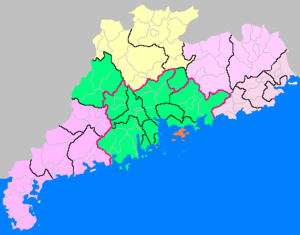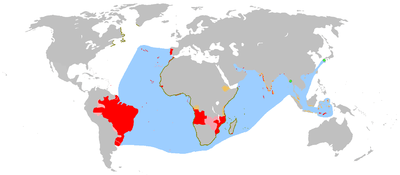Hengqin, formerly known as Dom João e Montanha, is an island in Zhuhai, a prefecture-level city and Special Economic Zone in the Guangdong province of the People's Republic of China. It has a population of about 3,000. Parts of Hengqin are leased to Macau by the State Council of the People's Republic of China in 2009.
The whole island is designated a special economic district, as Hengqin New Area, similar to Binhai New Area in Tianjin and Pudong New Area in Shanghai.
Geography
Hengqin Island is adjacent to Ilha da Taipa and Ilha de Coloane of Macau, and is connected to Macau's Cotai via the Lotus Bridge. The island is the largest among the 146 islands of Zhuhai, being roughly three times the size of Macau. It has broad bays, sandy beaches, strangely shaped jagged rocks, beautiful scenery, fresh air, and natural vegetation cover.
Hengqin was formerly made up of two islands, Xiao Hengqin (Portuguese: Dom João) and Da Hengqin (Portuguese: Montanha), which were recently connected as a result of land reclamation. The reclaimed island is 96 km2 (37 sq mi) large.
History
Portugal claimed both Xiao Hengqin and Da Hengqin, along with the larger former island of Wanzai (Portuguese: Lapa) — now a peninsula — to their north, as part of the Província da Macau, because "Portuguese schools are established there".[1] In 1896, Portuguese determined to occupy the two islands of Hengqin, but did not succeed in doing so. Portugal briefly occupied them before World War II.[2]
Since the land reclamation and development, there has been a growing opinion in Macau that the island should be leased to Macau, which has very limited land and little room for further development. By 1 September 2005, plans were revealed that the government of Guangdong will allow tax exemptions and adopt flexible immigration control in Hengqin to promote investment from Hong Kong and Macau.
In late 2005, Las Vegas Sands openly discussed its multi-billion dollar plan to develop parts of Hengqin Island into a convention and resort destination. The project was to include four million sq ft of convention space, hotels, retail, vacation homes, and golf, tennis and yachting amenities.[3][4]
On 27 June 2009 the government of Macau officially announced that the University of Macau would build its new campus on 1 km2 of the island, in a stretch directly facing the Cotai area, south of the current border post. This would be the first of other possible projects. Construction of the campus would take three years[5] and would include an underwater tunnel. Macau law would apply in the university campus and it would not be necessary to pass a formal border post.[6] The Macau Special Administrative Region will pay an amount of rent - which has not yet been set - for the use of the land.
Subdistricts of Hengqin New Area

A map of Hengqin New Area divided in 6 subdistricts
- Northwestern Zone - reserved for environmentally friendly development projects
- Northern Zone - A Bridge and main entrance between Central Zhuhai and Hengqin New Area
- Northeastern Exhibition Zone - development of an exhibition center and hotels
- Central Channel - develop as a leisure and recreational theme park
- Eastern Residential and Commercial Zone - codevelopment of PRC and Macau projects such as University of Macau's new campus
- Southern Tourist Zone - A future tourism attraction which is further divided into seven sub-zones
- Theme Park Area
- Seaside Hotel Area
- Natural Tourist Area
- Scenic Area
- Water Activities Area
- Seaside Holiday Resort Area
- Golf Course Holiday Resort Area
On 29 November 2010, the main body of the Chime-Long International Ocean Resort with an initial investment of 10 billion yuan kicked off the construction on Hengqin Island and is expected to become operational in 2013.
Also breaking ground is the “Ocean Kingdom” project, consisting of entertainment facilities, amusement rides, performances, high-tech experiences and animal watching as well as the dolphin-themed hotel with 1,888 guest rooms. Plans indicate that the ocean resort will cover Fuxiang Bay, Hengqin Hill and Dolphin Bay, with a total investment of over 20 billion yuan.
The entire project is being constructed in two phases. The first phase of 10 billion yuan involves mainly facilities in Fuxiang Bay and is due to become operational in 2013. The "Ocean Kingdom" is regarded as a "super theme park" with independent intellectual property rights. It is divided into eight themed zones, each consisting of the three main components of amusement designs, performances and animal watching.
The park will also house a night zoo, water world, the world’s highest ferris wheel, the longest wooden roller coaster as well as an advanced theatre.
The dolphin-themed hotel after completion is set to become the largest ecological-themed hotel in mainland China. It is expected that more than 20 million visitors from around the world will be attracted to the ocean resort once it is fully operational.[7]
References
External links
Subdistricts & Towns in Zhuhai |
|---|
| | Xiangzhou |
- Meihua
- Gongbei
- Jida
- Cuixiang
- Shishan
- Xiangwan
- Qianshan
- Wanzi
- Nanping
- Hengqin
- Tangjiawan
- Guishan
- Dan'gan
- Wanshan
|
|---|
| | Doumen |
- Baiteng
- Jing'an
- Baijiao
- Ganwu
- Doumen
- Lianzhou
|
|---|
| | Jinwan |
- Sanzao
- Hongqi
- Pingsha
- Nanshui
|
|---|
|
New Areas of the People's Republic of China |
|---|
| | East Coast | |
|---|
| | Central China | |
|---|
| | Northeast China | |
|---|
| | Western China | |
|---|
| | Defunct | |
|---|
| Note: with " * " are administrative divisions registered in the Ministry of Civil Affairs while other New Areas are established as economic management areas. With " ° " are State-level new area. |
|
Free-Trade Zone of the People's Republic of China |
|---|
| | Tianjin Free-Trade Zone |
- Tianjin Airport Economic Area
- Dongjiang Free Trade Port Zone
- Binhai New Area Central Business District
|
|---|
| | Shanghai Free-Trade Zone | |
|---|
| | Fujian Free-Trade Zone | |
|---|
| | Yuegang'ao Free-Trade Zone | |
|---|
|
|
|---|
| | Freguesias | | |
|---|
| | Other zones | |
|---|
| | Defunct subdivisions | |
|---|
| | Defunct territories | |
|---|
| |
|
|
|---|
| | North Africa |
|---|
|
|
15th century
|
16th century
|
|
| | | | Sub-Saharan Africa |
|---|
|
|
15th century
|
16th century
|
17th century
18th century
19th century
|
|
| | | Southwest Asia |
|---|
|
|
16th century
|
17th century
|
|
| | | Indian subcontinent |
|---|
|
|
15th century
16th century
Portuguese India
|
|
17th century
Portuguese India
18th century
Portuguese India
|
|
| | | East Asia and Oceania |
|---|
|
|
16th century
17th century
|
19th century
Portuguese Macau
20th century
Portuguese Macau
| • 1938–1941 | Lapa and Montanha (Hengqin)
|
|
- 1 1975 is the year of East Timor's Declaration of Independence and subsequent invasion by Indonesia. In 2002, East Timor's independence was fully recognized.
|
| | | North America and the North Atlantic Ocean |
|---|
|
|
15th century
|
16th century
|
|
|
| | | Central and South America |
|---|
|
|
16th century
|
17th century
18th century
|
19th century
|
|
| | |
|
Coordinates: 22°07′12″N 113°30′36″E / 22.1200°N 113.5101°E / 22.1200; 113.5101



